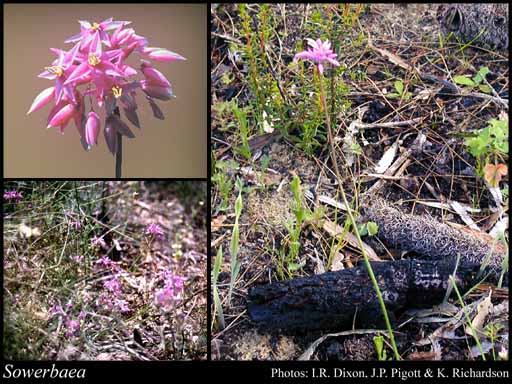- Reference
- Trans.Linn.Soc.London,Bot. 4:218 (1798)
- Name Status
- Current







Scientific Description
Family Anthericaceae.
Sometimes included in Liliaceae.
Habit and leaf form. Herbs (tufted); evergreen, or deciduous. Perennial (above ground parts more or less soft and annual). Leaves basal, or basal and cauline (few cauline leaves towards the base of the stem). Plants with a basal concentration of leaves, or with neither basal nor terminal concentrations of leaves; tuberous (may also lack a perennating organ). Self supporting, or climbing. Mesophytic, or xerophytic. Leaves alternate; spiral, or distichous; ‘herbaceous’, or leathery, or membranous; sessile; sheathing. Leaf sheaths not tubular; with free margins. Leaves edgewise to the stem, or with ‘normal’ orientation; simple. Leaf blades entire; flat, or solid; terete, or solid/angular (triquetrous); linear, or lanceolate, or oblong, or ovate; linear (narrowly, to filiform); parallel-veined; without cross-venules; sheathing, margins scariously winged. Leaves ligulate (wing margin of the leaf base fused distally at the top of the leaf sheath), or eligulate; without stipules. Leaf blade margins entire. Leaf anatomy. Hairs absent. Extra-floral nectaries absent. Stem anatomy. Secondary thickening absent.
Reproductive type, pollination. Fertile flowers hermaphrodite. Unisexual flowers absent. Plants hermaphrodite. Floral nectaries present. Nectar secretion from the gynoecium (from septal nectaries).
Inflorescence and flower features. Flowers aggregated in ‘inflorescences’; in umbels (or umbel-like), or in fascicles (or clusters). The terminal inflorescence unit cymose, or racemose (simple or compound). Inflorescences scapiflorous; terminal; flowering stem long, simple or few-branched, leafless; umbel many-flowered; with involucral bracts, or without involucral bracts; pseudanthial, or not pseudanthial. Flowers pedicellate (bracteate, exserted from the bracts; inner bracts fimbriate); bracteate (small, imbricate, scarious or not scarious, not pungent); ebracteolate; small, or medium-sized; regular; 3 merous; cyclic; pentacyclic, or tetracyclic. Perigone tube present. Perianth with distinct calyx and corolla (the whorls rather different), or of ‘tepals’; 6; 2 -whorled (3+3); isomerous; free, or joined (with a basal tube); petaloid; similar in the two whorls, or different in the two whorls; white, or pink (pale, to purple). Calyx (if the outer whorl so interpreted) 3; 1 -whorled; regular. Corolla (if the inner whorl so interpreted) 3; 1 -whorled; regular. Corolla members sometimes fringed. Androecial members definite in number. Androecium 3, or 6. Androecial members free of the perianth, or adnate (to the perianth); all equal; free of one another; 1 -whorled, or 2 -whorled. Androecium exclusively of fertile stamens, or including staminodes. Staminodes when present, 3 (in the form of staminal filaments). Stamens 3; all more or less similar in shape; isomerous with the perianth, or diplostemonous; on the receptacle, opposite the inner segments and at their base; alterniperianthial, or oppositiperianthial. Anthers basifixed; dehiscing via longitudinal slits; introrse; cells free to below their middle or to their base except for the abbreviated connective; tetrasporangiate. Gynoecium 3 carpelled. The pistil 3 celled. Carpels isomerous with the perianth. Gynoecium syncarpous; synstylovarious, or eu-syncarpous; superior. Ovary plurilocular; 3 locular; sessile. Gynoecium stylate. Styles 1; apical (or nearly so). Stigmas 1; 2–3 - lobed. Placentation axile. Ovules 0–6 per locule; arillate, or non-arillate; campylotropous (generally), or anatropous.
Fruit and seed features. Fruit fleshy; dehiscent; usually a capsule. Capsules loculicidal. Fruit 3 celled; few. Seeds endospermic. Cotyledons 1. Embryo straight to curved.
Taxonomic Literature
- Wheeler, Judy; Marchant, Neville; Lewington, Margaret; Graham, Lorraine 2002. Flora of the south west, Bunbury, Augusta, Denmark. Volume 1, introduction, keys, ferns to monocotyledons. Australian Biological Resources Study.. Canberra..
- Wheeler, J. R.; Rye, B. L.; Koch, B. L.; Wilson, A. J. G.; Western Australian Herbarium 1992. Flora of the Kimberley region. Western Australian Herbarium.. Como, W.A..